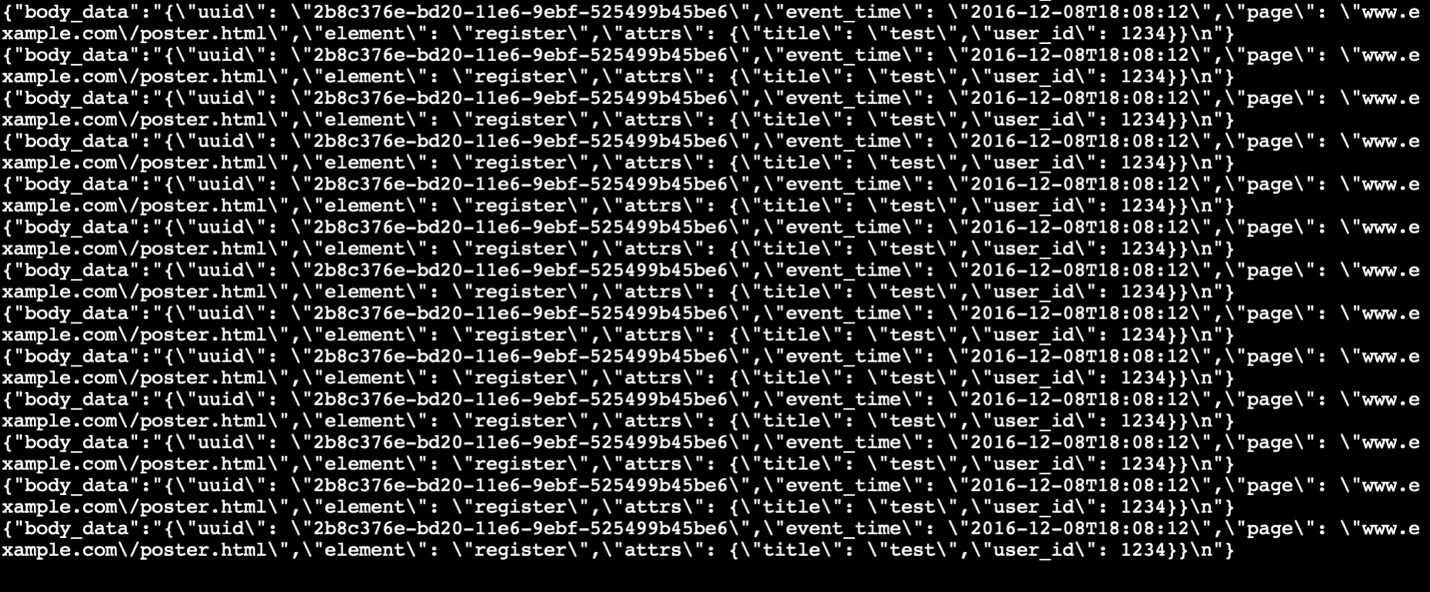前言
埋点数据一般取决于服务提供商想从用户身上获取什么信息。通常来讲,主要分为用户的基本属性信息和行为信息。用户的基本属性信息主要包括:年龄、性别、设备等。行为信息即用户的点击行为和浏览行为,在什么时间,哪个用户点击了哪个按钮,浏览了哪个页面,浏览时长等等的数据。 基本属性信息和行为信息又可以称之为一个简单的报文。报文是网络中交换与传输的数据单元,即站点一次性要发送的数据块。报文包含了将要发送的完整的数据信息,其长短很不一致,长度不限且可变。简单来说就是用户在 App 内有一个操作行为,就会上报一组带有数据的字段。
| 亚马逊云科技开发者社区为开发者们提供全球的开发技术资源。这里有技术文档、开发案例、技术专栏、培训视频、活动与竞赛等。帮助中国开发者对接世界最前沿技术,观点,和项目,并将中国优秀开发者或技术推荐给全球云社区。如果你还没有关注/收藏,看到这里请一定不要匆匆划过,点这里让它成为你的技术宝库! |
本文会演示如何利用开源软件和 Amazon 服务来构建服务端埋点系统,客户端部分不在本文的讨论范围内。
软件架构
Lua 是一种轻量级、可嵌入式的脚本语言,可以非常容易的嵌入到其他语言中使用。另外 Lua 提供了协程并发,即以同步调用的方式进行异步执行,从而实现并发,比起回调机制的并发来说代码更容易编写和理解,排查问题也会容易。Lua 还提供了闭包机制,函数可以作为 First Class Value 进行参数传递,另外其实现了标记清除垃圾收集。
OpenResty® 是一个基于 Nginx 与 Lua 的高性能 Web 平台,其内部集成了大量精良的 Lua 库、第三方模块以及大多数的依赖项。用于方便地搭建能够处理超高并发、扩展性极高的动态 Web 应用、Web 服务和动态网关。OpenResty® 通过汇聚各种设计精良的 Nginx 模块,从而将 Nginx 有效地变成一个强大的通用 Web 应用平台。这样,Web 开发人员和系统工程师可以使用 Lua 脚本语言调动 Nginx 支持的各种 C 以及 Lua 模块,快速构造出足以胜任 10K 乃至 1000K 以上单机并发连接的高性能 Web 应用系统。
通常会利用 Nginx&Lua 实现服务端日志的统一收集,笔者会利用这项技术实现埋点数据的收集,思路如下:
- 以 Http 请求的方式将埋点数据发送至 Nginx 端;
- 通过 Lua 模块解析请求体,再将埋点数据以异步的方式发送至后端 Kafka。这个过程中数据不用落盘,大大节约了存储空间和提高了效率;
- 最终后端会有一组消费者(例如 Spark)从 Kafka 中将数据落盘(例如 S3);
下图是本文软件层面的架构图。

整体架构

架构分为四大块:
- Amazon EKS,本文会将 Nginx 和 Lua 以容器的形式部署在 Amazon EKS 中,充分利用 EKS 的弹性;
- Amazon MSK,本文会使用托管的 Kafka,也就是 Amazon MSK,降低部署和后期运维的压力;
- Amazon EFS,考虑到整体架构的可用性和持久性,如果在 MSK 端发生了故障,虽然概率极低,本文会使用 Amazon EFS 来存储 Nginx 的错误日志,尽量保证消息的完整性;
- Amazon NLB,本文会使用 NLB 来暴露服务;
- Amazon ECR,本文会使用 ECR 来存储容器镜像;
步骤
在开始之前,请先确保您具有登录 Amazon 全球区控制台的账号,并具备管理员权限。
前提条件
- 一台 Linux 终端
- 足够的 Amazon 账号权限
- 安装 Amazon CLI
- 安装 Docker
- 安装 eksctl
- 安装 kubectl
一、创建 Amazon VPC和Security Group
参考此链接,创建 1个 VPC、3个公有子网、3个私有子网和其他 VPC 资源。接下来笔者会使用 vpcid, publicsubnetid01, publicsubnetid02, publicsubnetid03, privatesubnetid01, privatesubnetid02, privatesubnetid03来代替相关 VPC 和子网资源。
创建一个安全组供后续其他服务使用,为了简便配置,笔者会将本文使用到的资源放入同一个安全组中。读者可以在自己环境中将安全组进行拆分。
### $ aws ec2 create-security-group --group-name my-poc-sg --description " my-poc-sg " --vpc-id vpcid ###
记录 Security Group ID, 笔者会使用 securitygroupid 来代替它。
### $ aws ec2 authorize-security-group-ingress \ --group-id securitygroupid\ --protocol all\ --port -1 \ --source-group securitygroupid ###
二、创建 Amazon MSK
创建 Amazon MSK 集群来接收消息,并记录 Broker 地址,笔者会使用 broker01, broker02, broker03 来代替。
### $ aws kafka create-cluster \ --cluster-name "my-poc-msk-cluster" \ --broker-node-group-info file://brokernodegroupinfo.json \ --kafka-version "2.6.2" \ --number-of-broker-nodes 3 \ --encryption-info EncryptionInTransit={ClientBroker=TLS_PLAINTEXT} ### brokernodegroupinfo.json ~~~ { "InstanceType": "kafka.m5.large", "BrokerAZDistribution": "DEFAULT", "ClientSubnets": [ "privatesubnetid01", "privatesubnetid02", "privatesubnetid03" ], "SecurityGroups": [ "securitygroupid " ], "StorageInfo": { "EbsStorageInfo": { "VolumeSize": 100 } } } ~~~
三、构建镜像
使用到的文件包含:
- Dockerfile
- sh
- conf
- conf
- my-poc-send2kafka.lua
###
$ mkdir workdir
$ cd workdir
###
依次按照如下内容创建文件。
Dockerfile ~~~ FROM amazonlinux COPY install.sh / RUN chmod +x /install.sh RUN /install.sh COPY nginx.conf /opt/openresty/nginx/conf/nginx.conf COPY common.conf /opt/openresty/nginx/conf/conf.d/common.conf COPY my-poc-send2kafka.lua /opt/openresty/nginx/lua/my-poc-send2kafka.lua EXPOSE 80 CMD sed -i "s/\$mypodip/$(hostname -i)/g" /opt/openresty/nginx/conf/conf.d/common.conf && /opt/openresty/nginx/sbin/nginx -c /opt/openresty/nginx/conf/nginx.conf ~~~ install.sh ~~~ #!/bin/sh yum -y install readline-devel pcre-devel openssl-devel gcc wget tar gzip perl make unzip hostname mkdir /opt/software mkdir /opt/module cd /opt/software/ wget https://openresty.org/download/openresty-1.9.7.4.tar.gz tar -xzf openresty-1.9.7.4.tar.gz -C /opt/module/ cd /opt/module/openresty-1.9.7.4 ./configure --prefix=/opt/openresty \ --with-luajit \ --without-http_redis2_module \ --with-http_iconv_module make make install cd /opt/software/ wget https://github.com/doujiang24/lua-resty-kafka/archive/master.zip unzip master.zip -d /opt/module/ cp -rf /opt/module/lua-resty-kafka-master/lib/resty/kafka/ /opt/openresty/lualib/resty/ mkdir /opt/openresty/nginx/lua/ mkdir /var/log/nginx/ ~~~ nginx.conf ~~~ worker_processes auto; worker_rlimit_nofile 100000; daemon off; events { worker_connections 102400; multi_accept on; use epoll; } http { include mime.types; default_type application/octet-stream; log_format main '$remote_addr - $remote_user [$time_local] "$request" ' '$status $body_bytes_sent "$http_referer" ' '"$http_user_agent" "$http_x_forwarded_for"'; access_log /var/log/nginx/access.log main; resolver 8.8.8.8; #resolver 127.0.0.1 valid=3600s; sendfile on; keepalive_timeout 65; underscores_in_headers on; gzip on; include /opt/openresty/nginx/conf/conf.d/common.conf; } ~~~ common.conf ~~~ lua_package_path "/opt/openresty/lualib/resty/kafka/?.lua;;"; lua_package_cpath "/opt/openresty/lualib/?.so;;"; lua_shared_dict ngx_cache 128m; lua_shared_dict cache_lock 100k; server { listen 80; server_name 127.0.0.1; root html; lua_need_request_body on; access_log /var/log/nginx/access.log main; error_log /var/log/nginx/error-$mypodip.log notice; location = /putmessage { lua_code_cache on; charset utf-8; default_type 'application/json'; content_by_lua_file "/opt/openresty/nginx/lua/my-poc-send2kafka.lua"; } } ~~~ my-poc-send2kafka.lua ~~~ local producer = require("resty.kafka.producer") local json = require("cjson") local broker_list = { {host = "broker01", port = 9092}, {host = "broker02", port = 9092}, {host = "broker03", port = 9092} } local log_json = {} log_json["body"] = ngx.req.read_body() log_json["body_data"] = ngx.req.get_body_data() local topic = ngx.req.get_headers()["topic"] local producer_error_handle = function(topic, partition_id, queue, index, err, retryable) ngx.log(ngx.ERR, "Error handle: index ", index, ' partition_id ', partition_id, ' retryable ', retryable, ' json ', json.encode(queue)) end local bp = producer:new(broker_list, { producer_type = "async", batch_num = 200, error_handle = producer_error_handle}) local sendMsg = json.encode(log_json) local ok, err = bp:send(topic, nil, sendMsg) ~~~ ### $ docker build -t my-poc-image . ###
四、创建 Amazon ECR 并上传镜像
aws ecr create-repository \ --repository-name my-poc-ecr/nginx-lua ### $ aws ecr get-login-password --region regioncode | docker login --username AWS --password-stdin youraccountid.dkr.ecr.regioncode.amazonaws.com $ docker tag my-poc-image:latest youraccountid.dkr.ecr.regioncode.amazonaws.com/my-poc-ecr/nginx-lua:latest $ docker push youraccountid.dkr.ecr.regioncode.amazonaws.com/my-poc-ecr/nginx-lua:latest ###
五、创建 Amazon EFS
### aws efs create-file-system \ --performance-mode generalPurpose \ --throughput-mode bursting \ --encrypted \ --region ap-northeast-1 \ --tags Key=Name,Value=my-poc-efs ###
记录 FileSystemId,笔者会使用 fsid 来代替它。
### aws efs create-mount-target \ --file-system-id fsid \ --subnet-id privatesubnetid01 \ --security-groups securitygroupid aws efs create-mount-target \ --file-system-id fsid \ --subnet-id privatesubnetid02 \ --security-groups securitygroupid aws efs create-mount-target \ --file-system-id fsid \ --subnet-id privatesubnetid03 \ --security-groups securitygroupid ###
六、创建Amazon EKS集群并安装组件
cluster.yaml ### apiVersion: eksctl.io/v1alpha5 kind: ClusterConfig metadata: name: my-poc-eks-cluster region: ap-northeast-1 version: "1.21" iam: withOIDC: true addons: - name: vpc-cni version: v1.11.2-eksbuild.1 - name: coredns version: v1.8.4-eksbuild.1 - name: kube-proxy version: v1.21.2-eksbuild.2 vpc: subnets: private: ap-northeast-1a: { id: "privatesubnetid01" } ap-northeast-1c: { id: "privatesubnetid02" } ap-northeast-1d: { id: "privatesubnetid03" } managedNodeGroups: - name: my-poc-ng-1 instanceType: m5.large desiredCapacity: 2 volumeSize: 100 privateNetworking: true ### ### $ eksctl create cluster -f cluster.yaml ###
参考此链接安装 Amazon Load Balancer Controller。
参考此链接安装 Amazon EFS CSI driver。
七、在 Amazon EKS 中部署
### $ kubectl apply -f deploy.yaml ### deploy.yaml ~~~ --- kind: StorageClass apiVersion: storage.k8s.io/v1 metadata: name: efs-sc provisioner: efs.csi.aws.com parameters: provisioningMode: efs-ap fileSystemId: fsid directoryPerms: "700" gidRangeStart: "1000" gidRangeEnd: "2000" basePath: "/dynamic_provisioning" --- apiVersion: v1 kind: PersistentVolumeClaim metadata: name: my-poc-pvc spec: accessModes: - ReadWriteMany storageClassName: efs-sc resources: requests: storage: 5Gi --- apiVersion: apps/v1 kind: Deployment metadata: name: nginx-lua labels: app: nginx-lua spec: replicas: 2 selector: matchLabels: app: nginx-lua template: metadata: labels: app: nginx-lua spec: containers: - name: nginx-lua image: youraccountid.dkr.ecr.regioncode.amazonaws.com/my-poc-ecr/nginx-lua:latest ports: - containerPort: 80 resources: limits: cpu: 500m requests: cpu: 200m volumeMounts: - name: my-poc-volume mountPath: /var/log/nginx volumes: - name: my-poc-volume persistentVolumeClaim: claimName: my-poc-pvc --- apiVersion: v1 kind: Service metadata: name: nginx-lua-svc annotations: service.beta.kubernetes.io/aws-load-balancer-type: external service.beta.kubernetes.io/aws-load-balancer-nlb-target-type: ip service.beta.kubernetes.io/aws-load-balancer-scheme: internet-facing service.beta.kubernetes.io/aws-load-balancer-subnets: publicsubnetid01, publicsubnetid02, publicsubnetid03 service.beta.kubernetes.io/aws-load-balancer-name: my-poc-nginx-lua service.beta.kubernetes.io/aws-load-balancer-attributes: load_balancing.cross_zone.enabled=true spec: selector: app: nginx-lua type: LoadBalancer ports: - protocol: TCP port: 80 targetPort: 80 ~~~
使用以下命令获取 EXTERNAL-IP 地址,笔者会使用 nlbdns 来代替。
### $ kubectl get svc nginx-lua-svc ###
八、功能测试
参考此链接安装 kafka 客户端。
创建测试用 Topic。
### $ ./kafka-topics.sh --topic my-poc-topic-01 --create --bootstrap-server broker01:9092, broker02:9092, broker03:9092 --partitions 3 --replication-factor 2 ###
安装 ApacheBench 测试工具,并进行测试。
### $ sudo yum -y install httpd-tools $ ab -T 'application/json' -H "topic: my-poc-topic-01" -n 1000 -p postdata.json http://nlbdns/putmessage ### postdata.json ~~~ { "uuid": "2b8c376e-bd20-11e6-9ebf-525499b45be6", "event_time": "2016-12-08T18:08:12", "page": "www.example.com/poster.html", "element": "register", "attrs": { "title": "test", "user_id": 1234 } } ~~~
查看消息是否可以成功消费。
### ./kafka-console-consumer.sh --bootstrap-server broker01:9092, broker02:9092, broker03:9092 --topic my-poc-topic-01 --from-beginning ###
消息已经成功消费。

接下来笔者会给一个不存在的 topic 发送消息,用来模拟生产环境中后端 MSK 不可用的情况。
### $ ab -T 'application/json' -H "topic: my-poc-topic-noexist" -n 1000 -p postdata.json http://nlbdns/putmessage ###
按照预想状况,这部分消息会以错误日志的形式保留在 Amazon EFS 中。
### $ ab -T 'application/json' -H "topic: my-poc-topic-noexist" -n 1000 -p postdata.json http://nlbdns/putmessage ###
进入 EFS 中,打开带有 pod ip 的错误日志,可以看到错误信息被记录了下来。

本篇作者

杨探
亚马逊云科技解决方案架构师,负责互联网行业云端架构咨询和设计。
文章来源:https://dev.amazoncloud.cn/column/article/6309d47976658473a321ffdc?sc_channel=bokey